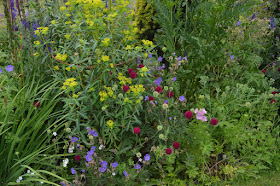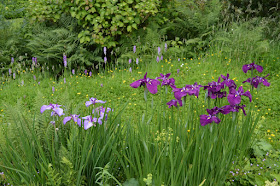 |
| Intermingling as a planting strategy works well at Little Ash Bungalow with things like Knautia macedonica, which often needs support for its rangy stems. |
Here I'd like to look at the planting in these two gardens, concentrating on some key aspects of naturalistic planting: density, intermingling, self-sowing, spontaneous native plants and integration with nature.
Little Ash Bungalow, is a Yellow Book garden, which Helen Brown has made into a new-style plantsman's garden. It illustrates well just how effective the higher density of planting that is so crucial to naturalistic planting can be when used with good plant combinations - for which this garden is an excellent example.
Conventional planting with its separation of plant from plant and bare soil now seems so much a thing of the past. Whilst we are still a long way from the density of natural plant habitats, the modern planting style has a kind of voluptuous freedom about it, which is a joy to see.
Helen's garden is mostly herbaceous but some strongly structural stuff as well. Grasses make good space fillers.
Whilst here there is not much of the conscious repetition with the true intermingled planting style aims at, dense naturalistic planting is such a good way of managing and making the most of the wide range of plant forms which herbaceous perennials take, and which people like Helen like to cram into their borders. NONE OF WHICH are to be found growing on their own in splendid isolation in nature - ok, there are exceptions but they are very few; Meadowsweet (Filipendula ulmaria) is one which does, but that is another story. The overwhelming majority of perennials grow cheek by jowl with many others, and physically intermesh and hold each other up, interpenetrate each other, so there is often a visual intermingling from a limited number of plants. The planting at Little Ash illustrates this extremely well.
Self-sowing, self-seeding, whatever you would like to call it, is a crucial part of the new naturalism. Although progressive gardeners from Margery Fish onwards have promoted it, it is now really only coming into its own. Burrow Farm garden is a good place to appreciate it. This expansive and ambitious garden has been made over many years by Mary Benger on land which has presumably been gradually acquired from her husband's farm - a successful example of agricultural diversification, and one which, because it is open to the public as a business means it is a very accessible place to get to, to see how traditional English mixed planting style is morphing into a distinctly naturalistic one. Self-sowing is a big part of what makes Burrow Farm successful visually.The sheer scale of Burrow Farm and its very subtle transitions from one area to another is quite something, and of course it illustrates well that naturalistic planting is the obvious way to manage such extensive areas. I would love to see Mary being put in charge of Wisley for a few years.
Scenes like this which counterpoint very conventional and almost cliched English garden features like bird baths with seeding perennials would once have been seen as a sign of neglect. How far we have come!
The partial acceptance and management of what turns up in the borders on its own is another crucial aspect of naturalistic planting. Here is hemlock! Yes! The stuff that killed Socrates. There is even some giant hogweed lurking down by a pond.
Finally, there is the integration of cultivated plants with more fully semi-natural habitat like these Iris ensata matching the colours of some wild orchids - common spotted (Dactylorhiza fuchsii) but which seems to hybridising with some garden ones (D. foliosa) with their deeper colours. Managing the boundaries and borderlines between what a naturalist would unhesitatingly call 'habitat' and the gardener 'border' is one of the ecological-artistic skills of the new naturalistic gardener.Of course doing good naturalistic planting does depend greatly on understanding plants. In collaboration with My Garden School I have published the first of what is intended to be a series on planting design. It is very much a textbook, written with a global audience of non-English speakers in mind, for anyone and everyone who is involved with planning or planting vegetation, from amateurs to landscape architects. This first book is aimed at understanding the basics of plants through their ecology.
Here it is on the amazon site.
* * * * *
If you like this blog, why not check out my e-books, which are round-ups of some writing I did for Hortus magazine back in the early 2000s, along with an interview with the amazing Beth Chatto. You can read them on Kindle, or Kindle packages for smartphones or the computer. You can find them on my Amazon page here. You will also find my soap opera for gardeners - currently running at eight episodes.
SUPPORT THIS BLOG
I write this blog unpaid (of course)
and try to do two postings a month, to try to provide the garden,
wildflower and plant-loving community with information, inspiration
and ideas. Keeping it coming is not always easy to fit into a busy
working life. I would very much appreciate it if readers would 'chip
in' (as we say in England) and provide a little financial support.
After all, you pay for magazines and books, and it is only for
historical reasons that the internet is free. Some money coming in
will help me to improve quality and frequency, and to start to
provide more coherent access to hard information, which I know is
what a lot of you really want. So – please donate now!! You can do
this through PayPal using email address: noelk57@gmail.com
Thank you!
And thank you too to the folk who have contributed so far.
********









Great post coalescing the elements and cautions of naturalistic planting !
ReplyDeleteAre you sure that the plant collectors' cottage garden isn't just sneaking back under a new title?
ReplyDeleteXxxx Anne
Great post and lovely photos. I'm a complete gardening novice so don't really have a style of planting yet. However, I am drawn more to the naturalistic plantings. I suspect for me Anne might be right, I'm a collector and hoarder of plants, so 'naturalistic' helps with that :)
ReplyDelete